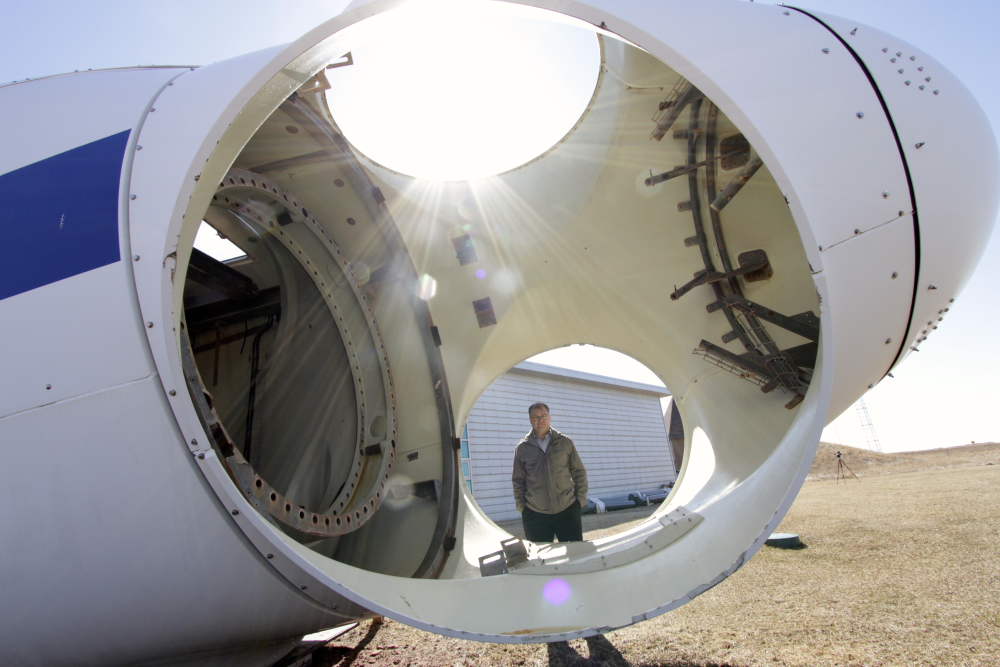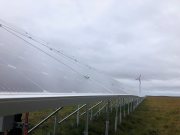Long before you get to the North Cape of Prince Edward Island, you see them on the horizon. Wind turbines, spinning in tandem, go from the size of your pinky to towering edifices as you get closer to Seacow Pond along highway 12.

Just beyond the road, freshly-launched boats of all sizes tug against the ropes securing them to the wooden docks. All around, fishers inspect their motley boats and traps in preparation for impending lobster season.
We are on our way to the Wind Energy Institute of Canada on the northwest tip of, what the locals call, “the Island."
As we reach the termination of Highway 12, the red rocky beaches of the North Cape surround me on three sides. There is a lighthouse and wind turbines of every shape and size. Here, the PEI Energy Corporation operates a 13.6 megawatt wind farm while the Wind Energy Institute has its own 10 megawatt wind farm in addition to an assortment of wind turbines small and large undergoing various tests.
 Today nearly 147,000 people make their home in this lush agricultural maritime province. Often called the Cradle of Confederation, the seeds of our nation having been sewn here in 1864 at the Charlottetown Conference.
Today nearly 147,000 people make their home in this lush agricultural maritime province. Often called the Cradle of Confederation, the seeds of our nation having been sewn here in 1864 at the Charlottetown Conference.
The economy of PEI is fueled by agriculture, tourism and the fishery. Also, the province just happens to have the highest level of wind power integration in North America.
The Wind Energy Institute of Canada (WEICan) evolved out of “The Atlantic Wind Test Site, which was founded on North Cape in 1981. Scott Harper, the CEO of WEICan, meets me outside the institute.
"Its location was its prime focus,” says Harper. “There's a very strong, solid wind regime with 300 degrees of exposure to the ocean, which made it an ideal test ground for turbines of various stages,”
A new name and new mandate
With research money drying up, the institute rebranded as WEICan in 2005 and in 2013 christened their own 10 megawatt wind farm as a living lab and an innovative means of generating 85 per cent of their revenue.
Today they foster relationships with 10 universities, work as consultants with industry, and are recognized as experts in wind energy integration.
“With Prince Edward Island being a fairly small province, we can put 10 megawatts of wind in, which in Ontario or Alberta would be a very, very small part of the system,” says Harper. “We're actually relevant here, it's a major portion of our generation.”
“The other thing that's interesting about PEI is, with the exception of some diesel that's there for peaking and back up, the energy that's produced here is the only on-island generation," says Harper. "We rely on connection to the mainland for the remainder of our electricity. So as we see our penetration over the last few years has gone from one or two per cent to 26 per cent, and we believe will be 30 per cent this year."
With an average wind speed of nearly 9 metres per second, the North Cape is pretty much the ideal location for the institute and their wind farm.
"Our turbines have a 93-metre rotor with a two megawatt generator. Our capacity factor last year was around 51 per cent, which is quite high.”
Walking the talk – wind powers the institute and PEI
Capacity factor is geek speak for the percentage of electricity produced by a wind turbine, compared to its rated capacity An average of 51 per cent capacity factor is considered among the best in Canada. During the winter, PEI’s wind resource is even stronger.
“This past January we had a very solid month," says Harper. "It seemed the wind blew every day, our capacity factor just tipped over 69 per cent."
Two years ago the institute installed a two megawatt battery storage system to learn more about how energy storage can help integrate renewable energy.
Harper says they have used the batteries to help provide power for their own use when the wind isn’t blowing. They're testing energy storage for time shifting, demand and energy avoidance, diesel displacement and frequency regulation.
“We are seeing some value coming to us for these means now. I wish I could say it was paying for the battery fully, it isn't,” says Harper.
He says the batteries are helping the institute work with partners to examine different uses of battery storage to determine the value the services provide.
The Wind Energy Institute does consulting work, undertakes research and even has the expertise to certify wind turbines. But, like many involved with renewable energy, Harper and his team know that wind isn’t the answer to every energy problem.
PEI has only had about 67 solar systems installed since 2008, but Harper wonders if solar can compliment wind power: “Solar is likely to be generating at those peak times of the day when the sun's still out and energy use is high,” says Harper who explained that wind tends to be stronger in winter and at night while solar is stronger in the summer and during the day.
PEI is now developing a new energy strategy. It looks like the province will invest in two new undersea cables to New Brunswick to assure they have a reliable supply from off-island.
There are some who say PEI is tapped out on it’s renewable energy, but after speaking to the energy minister, the CEO of the PEI Energy Corporation, Summerside’s utility manager and Scott Harper of the institute it seems pretty clear PEI is determined to do more.










